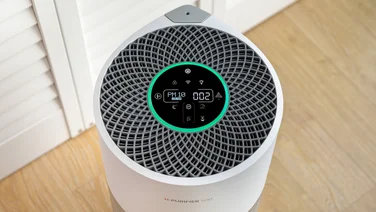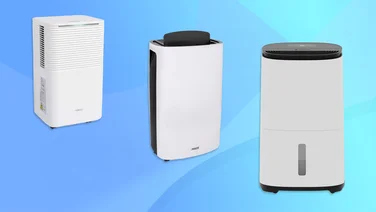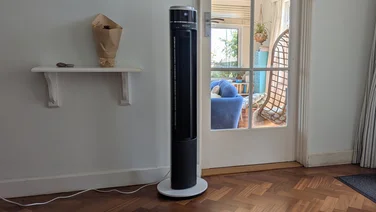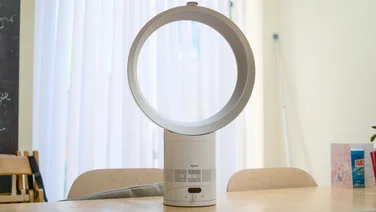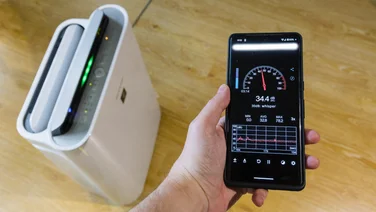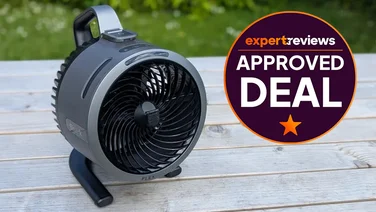To help us provide you with free impartial advice, we may earn a commission if you buy through links on our site. Learn more










- Clever pivoting design
- Good for cooling while you snooze
- Tilting and oscillating gets the airflow where you need it
- Too noisy at higher speeds
- Indicators aren’t clear enough
- Power-hungry and expensive
I’ve seen my share of tower fans, but nothing quite like the new Shark TurboBlade. Even by the standard of bladeless tower fans it’s a distinctive design with an extending column rising up from a drum that contains the motor. To this, a slimmer two-part ‘blade’ is attached with the edge lined by vents to direct the airflow.
Now comes the clever bit. Not only can you tilt the two parts of the blade in different directions to shift the airflow one way or the other, but the whole blade can pivot through 90 degrees to make the airflow horizontal rather than vertical. What’s more, all this can oscillate to spread the cooling even wider.
It’s an eye-catching design, but is it actually effective at helping you cool down? I’ve had the TurboBlade up and running during an unusually hot June week, testing and trying to work that out.
What do you get for the money?
The TurboBlade is a 112cm-tall tower fan with the aforementioned pivoting design. This gives it a degree of height adjustment, with the fan extending in vertical mode to reach a 128cm height, or going between 112cm and 128cm when used in the horizontal or “air blanket” mode.
The blades with the vents in them can twist through 180 degrees, and the fan as a whole can oscillate back and forth through up to 180 degrees. The bladeless design (in the sense that there are no visible fan blades) makes the fan easy to keep clean, while a filter protects the internal fan that creates the airflow from dust and grime.










There’s just one control on the fan itself, which doubles for power and fan speed, plus a series of five white LED indicators to tell you the current settings and speed. It’s clear Shark expects you to use the bundled compact remote control, which allows you to control the speed and oscillation, set the mode and user the timer, and even make the fan rotate to point in your general direction. The remote attaches magnetically to the pivot point connecting the two blades to the main tower.










There are a lot of moving and movable parts on this fan, so it’s a good thing that it’s well-built and beautifully engineered, with everything sliding, twisting and locking neatly into place. At 6.45kg it’s fairly bulky and heavy, and so a bit of a pain to move from room to room, but at least it feels like it will survive a good few years before it’s going to need replacing.
What features and settings does it have?
Beyond the ten speed standard speed settings you get a Boost mode, which basically ramps the speed one notch further up to 11. There’s also a Sleep mode that keeps the fan quiet and dims the indicators, plus a Breeze mode designed to give a natural wind effect. You can tailor the oscillation to move through 45, 90 or 180 degrees.
How does it perform?
This isn’t the fan to buy if you’re looking for a massive blast of air. On its minimum settings, you’ll barely feel anything and it struggled even get the blades on my anemometer moving. I registered the airflow at one metre at 0.4 to 0.6m/sec. It’s better around the halfway mark, reaching 1.3m/sec at setting 4, 1.5m/sec at setting 5 and 1.7m/sec on setting 6.
It’s only at the highest settings where things get really gusty, hitting 2.6m/sec at maximum normal speed and reaching 2.7m/sec in boost mode. To be fair, most tower fans max out at around 2.3 to 2.6m/sec, with only a few like the Levoit Classic Pro Smart Tower Fan reaching the heady heights of 3m/sec and over.










The problem is that – at the higher settings – the TurboBlade gets pretty noisy. At minimum speed it’s not bad, putting out 30.2dBA, but put the speed up to the halfway mark and that rises to 40.8dBA. At full speed it reaches 51.5dBA, and on Boost you’re looking at upwards of 53 to 55.5dBA. That puts it right up there with the Levoit Classic Pro as one of the loudest tower fans we’ve tested.
At first, I had the horizontal mode down as something of a gimmick, but then I checked out Shark’s blurb on the website product page, and realised it made sense for some bedroom cooling. Stick the TurboBlade at the end or side of the bed, pivot to horizontal mode and set the height correctly, and you can get a nice cooling airflow washing over you when you’re about to try and get some shuteye. For noise reasons, you’ll want to keep the speed low, but it’s still quite effective. In fact, at speed settings two to five you can get a very likeable light breeze.










In vertical mode, it’s also great for spreading a gentle airflow around a corner or a side of your living room. If you’re happy to use it at closer quarters, it’s not bad while you’re working at your desk. It goes quite easy on you, compared to would-be wind machines like the Meaco Sefte 10 Pedestal and Table fans.
Is there anything we didn’t like?
Obviously, the noise might be an issue, but power consumption is also on the high side. I measured usage at 4.5W on the lowest speed, climbing to 14.2W at medium speed and a whacking 50.8W on speed ten. That’s unusually high, even for a tower fan. The Dyson CF1, for comparison, produces a stronger air stream at maxiumum power and never consumes more than 21W.










I’m also not a huge fan of the way the LED indicators work, either. There are only five, so when you’re setting speeds you cycle through them once for the first five speeds, then again for the second five. For oscillation or setting the timer, you need to work out what the indicators actually mean, with the timer setting particularly obscure. A digital display might have seemed less elegant, but it would also be easier to read.
Should you buy the Shark TurboBlade fan?
The TurboBlade is one striking tower fan, and its ingenious design makes it a good option for bedroom use. All the same, it’s a lot more expensive than more conventional tower fans, while its noise levels and airflow aren’t anything special.
There’s a lot to like about this innovative, twisting, turning tower fan, and I do like the horizontal ‘air blanket’ it produces. All the same, you might expect something closer to perfection at this price.

